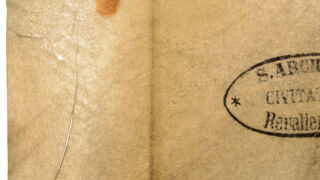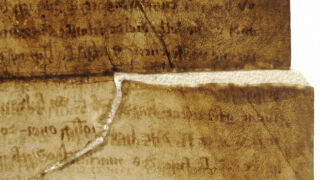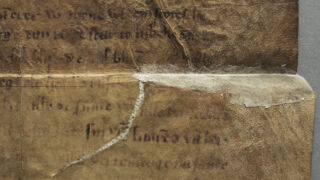C 6.8. Tears, splits
C6 damage sub-categories:
C6 damage sub-categories:
C 6.1. Rust accretion, foxing
C 6.2. Glass-like layers
C 6.3. Stains, accretion
C 6.3.1. Handling marks
C 6.3.2. Ink stains
C 6.4. Ink corrosion
C 6.5. Ink loss; fading
C 6.6. Offset
C 6.7. Ink flake off; detachment of the parchment
C 6.8. Tears, splits
C 6.9. Pleats
C 6.10. Cockling
C 6.11. Curling
C 6.12. Pleats, double folds
C 6.13. Folds
C 6.14. Contraction, shrinkage
C 6.15. Internal loss
C 6.16. Edge loss
C 6.17. Blooms; calcite deposits
C 6.18. Micro-biological damage, mould, grazing
C 6.19. Brittleness
C 6.20. Rigidity, stiffness
Parchment cracking without the loss of material.
A tear is usually an unbroken break through the parchment that begins at the edge without any noticeable loss of material. A split is a narrow sharp break in a (usually rigid) material without complete the separation of the material into pieces.
Tears and splits may be caused by careless handling, improper storage, or intentional splitting when the document is annulled. However, as the parchment degrades, internal stresses can occur that are strong enough to split the parchment.

Rebend, lõhe.
Pärgamendi lõhestumine ilma materjali kaota.
Pärgamendi töötlemise käigus tekkinud lõhe.
Dokumenteeritud läbivas valguses.

Ürik TLA.230.1.BE_14/viii, 1503. a.
Rebend, lõhe.
Pärgamendi lõhestumine ilma materjali kaota. Dokumenteeritud läbivas valguses.
Rebend on toestatud uue pärgamendiga.

Ürik TLA.230.1.BE_14/viii, 1503. a.
Rebend, lõhe. Pärgamendi lõhestumine ilma materjali kaota.
Parandamiseks kasutatud uus pärgament on liimitud tugt rebenenud pärgamendi rebendile toeks.

